List of Sites of Special Scientific Interest in Buckinghamshire
Buckinghamshire is a county in south-east England.[1] Its county town is Aylesbury,[2] and it is surrounded by Northamptonshire to the north, Bedfordshire, Hertfordshire and Greater London to the east, Surrey and Berkshire to the south, and Oxfordshire to the west.[3] Under Buckinghamshire County Council there are four districts, Aylesbury Vale, Chiltern, South Bucks and Wycombe, while Milton Keynes has a separate unitary borough council.[4] Buckinghamshire has an area of 1874 km², and a population of 739,600.[5]
In England, Sites of Special Scientific Interest (SSSIs) are designated by Natural England, which is responsible for protecting England's natural environment. Designation as an SSSI gives legal protection to the most important wildlife and geological sites.[6] As of April 2016, there are 65 SSSIs in this Area of Search, 55 of which have been designated for biological interest and 10 for geological interest.[7] Thirty are in the Chilterns Area of Outstanding Natural Beauty, three are in National Nature Reserves, four are in Special Areas of Conservation, and seventeen are managed by the Berkshire, Buckinghamshire and Oxfordshire Wildlife Trust.
Key
Interest
|
Public access
|
Other classifications
|
Sites
| Site name | Photograph | B | G | Area[lower-alpha 1] | Public access |
Location[lower-alpha 1] | Other classifications |
Map[lower-alpha 2] | Citation[lower-alpha 3] | Description |
|---|---|---|---|---|---|---|---|---|---|---|
| Ashridge Commons and Woods | 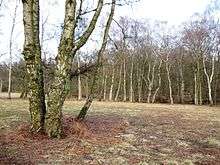 |
640.1 hectares (1,582 acres) | YES | Ashridge 51°48′42″N 0°35′14″W / 51.8116°N 0.5871°W SP975135 |
CAONB,[8] NT[8] | Map | Citation | This site is mainly semi-natural vegetation, with has extensive areas of woodland, grass and scrub. There are many species of breeding birds, including some which are rare nationally, such as firecrests.[8] | ||
| Aston Clinton Ragpits | 2.9 hectares (7.2 acres) | YES | Aston Clinton 51°47′20″N 0°42′50″W / 51.7888°N 0.7140°W SP888108 |
BBOWT,[9] CAONB[9] | Map | Citation | This grassland site has steeply sloping old pits and spoil heaps, with a rich assembly of shrubs, herbs and invertebrates, including twenty-seven butterfly species. There is some mature woodland with beech, yew, ash and whitebeam, together with a hedge and areas of scrub.[9] | |||
| Aston Rowant |  |
128.5 hectares (318 acres) | YES | Aston Rowant 51°40′08″N 0°56′55″W / 51.6689°N 0.9487°W SU728972 |
CAONB,[10] NCR,[11] NNR,[10] SAC[12][13] | Map | Citation | This site has beech woodland, scrub and chalk grassland. Unusual plants in the ground flora include wood barley, and the orchids Violet and white helleborine. There are several uncommon species of beetles and moths, and fifty breeding bird species.[14] | ||
| Aston Rowant Woods |  |
209.7 hectares (518 acres) | YES | Aston Rowant 51°40′46″N 0°55′00″W / 51.6794°N 0.9167°W SU750984 |
CAONB,[15] NCR,[16] NNR,[17] SAC[18][19] | Map | Citation | The site is described by Natural England as "of national importance as a large, unfragmented area of ancient semi-natural woodland characteristic of the Chilterns scarp". Flora include 52 species indicative of ancient woods, and there are over 100 species of fungi.[20] | ||
| Bacombe and Coombe Hills | 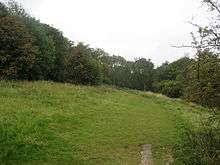 |
76.4 hectares (189 acres) | YES | Upper Bacombe 51°45′12″N 0°46′02″W / 51.7534°N 0.7671°W SP852068 |
BBOWT,[21] CAONB,[22] LNR,[23] NT[24] | Map | Citation | The site is chalk grassland which has a rich variety of species. including the entire British population of fringed gentian, and there are areas of juniper and mixed scrub. Invertebrates include scarce species, such as chalkhill blue and brown argus butterflies.[25] | ||
| Bierton Clay Pit | 0.1 hectares (0.25 acres) | NO | Bierton 51°50′01″N 0°47′02″W / 51.8336°N 0.7838°W SP839157 |
GCR[26] | Map | Citation | This disused clay pit exposes a section from the late Jurassic Kimmeridgian and Tithonian stages, between about 157 and 145 million years ago. It is the only exposure of the northern end of the Portland Beds, and shows the relationship between the Beds and the Hartwell Clay.[27] | |||
| Black Park | 15.3 hectares (38 acres) | YES | Wexham 51°32′51″N 0°32′26″W / 51.5476°N 0.5405°W TQ013842 |
LNR[28] | Map | Citation | This site has heath, alder carr - both rare in the county - mixed and coniferous woodland and some areas of acid grassland. It has a varied fauna, and insects include the nationally rare Roesel's bush cricket. There are 18 species of butterfly, and birds including hobbies and nightjars.[29] | |||
| Bolter End Sand Pit | 0.3 hectares (0.74 acres) | NO | Bolter End 51°37′13″N 0°50′50″W / 51.6203°N 0.8473°W SU799919 |
GCR[30] | Map | Citation | The site is part of the Reading Beds, and dates to 53 million years ago. It appears to represent riverine layers with sources from much older Lower Cretaceous and Upper Jurassic sequences.[31] | |||
| Bradenham Woods, Park Wood and The Coppice | 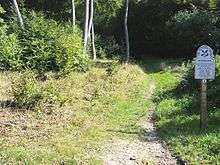 |
129.1 hectares (319 acres) | YES | Bradenham 51°40′42″N 0°48′14″W / 51.6783°N 0.8039°W SU828984 |
CAONB,[32] NCR,[32] NT,[33] SAC,[33] SM[34] | Map | Citation | The site is mainly beech woodland, with a rich ground flora including rare species. Twenty-eight species of butterfly have been recorded. There are also areas of chalk grassland.[32] | ||
| Bugle Quarry | 0.1 hectares (0.25 acres) | NO | Hartwell 51°48′07″N 0°51′05″W / 51.8019°N 0.8514°W SP793121 |
GCR[35][36] | Map | Citation | The site spans the late Jurassic, and the early Cretaceous, 152 to 139 million years ago.[35] Dinosaur teeth include those of Pelorosaurus, which are the only sauropod teeth of Tithonian (late Jurassic) age in Europe.[37] | |||
| Burnham Beeches | .jpg) |
374.6 hectares (926 acres) | PP | Farnham Common 51°33′44″N 0°37′51″W / 51.5622°N 0.6309°W SU950857 |
NNR,[38] SAC,[39] SM[40] | Map | Citation | This site has diverse habitats, ancient oak and beech pollards, wet heath and bog, alder wood, ponds and a stream. There are dormice, 56 bird species and some very rare beetles.[41] | ||
| Buttlers Hangings | 3.9 hectares (9.6 acres) | YES | Bradenham 51°39′31″N 0°49′13″W / 51.6587°N 0.8203°W SU817962 |
CAONB[42] | Map | Citation | The site is steeply sloping grassland and scrub which has a wide variety of plant species. There are many rabbit burrows and a badger sett. Invertebrates include colonies of chalkland butterflies and four endangered Red Book spiders.[42] | |||
| Dancersend | 81.3 hectares (201 acres) | YES | Wendover 51°46′34″N 0°41′49″W / 51.7760°N 0.6969°W SP900094 |
BBOWT,[43] CAONB,[44] FC[44] | Map | Citation | This reserve has woodland plantations, unimproved chalk grassland and scrub. The woods have few mature trees as most were felled during the 1940s, but a rich ground flora includes plants associated with ancient woodland, such as hairy brome and wood melick.[44] | |||
| Dancersend Waterworks | 4.0 hectares (9.9 acres) | NO | Hastoe 51°46′21″N 0°41′18″W / 51.7724°N 0.6883°W SP906090 |
CAONB,[45] LB[46] | Map | Citation | The site is an area of artificial banks, basins and plateaux in a chalk valley bottom, which has an unusually wide variety of herbs, grasses and shrubs. There is a badger sett and a range of butterfly and bird species.[45] | |||
| Ellesborough and Kimble Warrens | 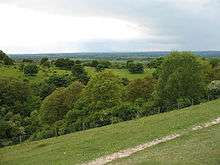 |
68.9 hectares (170 acres) | YES | Ellesborough 51°44′41″N 0°47′52″W / 51.7447°N 0.7978°W SP831058 |
CAONB,[47] SM[48] | Map | Citation | This is one of the most important sites in the Chilterns for natural box woodlands, and it also has grasslands with rare plant species. There is a wide range of invertebrates and breeding birds.[47][49] | ||
| Fayland Chalk Bank | 0.6 hectares (1.5 acres) | NO | Parmoor 51°35′30″N 0°51′55″W / 51.5917°N 0.8653°W SU787887 |
CAONB[50] | Map | Citation | The site is chalk grassland which has a diverse flora. Orchids include the common spotted and pyramidal, and the profusion of chalk flowers and its south facing location make the site important for bees, grasshoppers and butterflies.[50] | |||
| Fern House Gravel Pit | 1.3 hectares (3.2 acres) | NO | Bourne End 51°35′18″N 0°43′36″W / 51.5884°N 0.7268°W SU883885 |
GCR[51] | Map | Citation | This site may help to elucidate the history of the River Thames between glacial Anglian stage, around 450,000 years ago, when the river was diverted south to its present course, and the warm Ipswichian around 120,000 years ago. Fossils include straight-tusked elephants and mammoths.[52][53] | |||
| Finemere Wood |  |
45.7 hectares (113 acres) | YES | Quainton 51°53′24″N 0°57′29″W / 51.8901°N 0.9581°W SP718218 |
BBOWT[54] | Map | Citation | Most of the site is ancient pedunculate oak forest, which has butterflies including the rare wood white and black hairstreak. There is also an area of rough grassland and scrub which is crossed by the River Ray.[55][54] | ||
| Foxcote Reservoir and Wood | 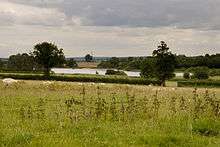 |
48.3 hectares (119 acres) | NO | Akeley 52°01′17″N 0°57′55″W / 52.0215°N 0.9653°W SP711364 |
BBOWT[56] | Map | Citation | The reservoir is important for wintering wildfowl, especially shoveler ducks and Bewick's swans. The area around the reservoir has woodland, meadows and ponds. Plants include the greater butterfly orchid and the herb Paris quadrifolia.[57] | ||
| Frieth Meadows | 2.5 hectares (6.2 acres) | NO | Frieth 51°36′28″N 0°50′51″W / 51.6077°N 0.8476°W SU799905 |
Map | Citation | The site consists of traditionally managed and unimproved meadows on neutral to acid soils. Plants include quaking grass, green-winged orchid, lousewort and devil's bit scabious. Grassland and hedgerows have a wide range of invertebrates.[58] | ||||
| Froghall Brickworks | 0.7 hectares (1.7 acres) | NO | Chalfont St Giles 51°38′14″N 0°35′23″W / 51.6372°N 0.5896°W SU977941 |
Map | Citation | The site is Pleistocene gravel above Reading beds. The gravel was deposited by the proto-River Thames, before it was diverted south by the Anglian Ice Age around 450,000 years ago.[59] | ||||
| Frogmore Meadows | 4.6 hectares (11 acres) | YES | Chenies 51°40′47″N 0°31′29″W / 51.6796°N 0.5247°W TQ021989 |
CAONB[60] | Map | Citation | The site has marshy areas and fens next to the river, damp grassland and drier, more acidic areas. The river bank has water voles, and damp areas are dominated by meadow foxtail and Yorkshire fog, with some marsh marigold and marsh bedstraw.[61][62] | |||
| Gomm Valley | 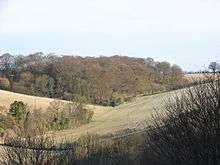 |
4.1 hectares (10 acres) | YES | Micklefield 51°37′17″N 0°42′21″W / 51.6215°N 0.7057°W SU897922 |
BBOWT,[63] CAONB[64] | Map | Citation | The site is chalk grassland which is reverting to scrub. It has a rich variety of herbs and of invertebrates, and is notable for reptiles and over-wintering birds, particularly thrushes. Over 30 species of butterflies and 180 of moths have been recorded.[65][63] | ||
| Grangelands and Pulpit Hill | 25.5 hectares (63 acres) | YES | Cadsden 51°44′15″N 0°48′03″W / 51.7376°N 0.8009°W SP829050 |
BBOWT,[66] CAONB,[66] NT[66] | Map | Citation | The site has grassland and scrub, which support interesting breeding birds and invertebrates, such as glow-worms and marbled white and chalk hill blue butterflies. There are areas of mature beech woodland, with a sparse shrub layer of holly and elder.[66] | |||
| Grendon and Doddershall Woods |  |
67.1 hectares (166 acres) | YES | Grendon Underwood 51°52′53″N 0°59′09″W / 51.8814°N 0.9859°W SP699208 |
Map | Citation | The site is broadleaved oak woodland on north Buckinghamshire clay, with an understorey of hazel and blackthorn. Herbs include primrose and wood anemone, and small streams and wide rides provide additional habitats. The woods have 35 butterfly species, including the rare black hairstreak.[67] | |||
| Ham Home-cum-Hamgreen Woods | 23.2 hectares (57 acres) | YES | Grendon Underwood 51°51′55″N 0°59′32″W / 51.8653°N 0.9921°W SP695190 |
Map | Citation | The site is ancient woodland on clay, with a varied structure, and a rich variety of flora and invertebrates. The site has the largest British breeding colony of the nationally rare black hairstreak butterfly.[68] | ||||
| Hodgemoor Wood | 102.6 hectares (254 acres) | YES | Chalfont St Giles 51°37′55″N 0°36′10″W / 51.6320°N 0.6028°W SU968935 |
CAONB,[69] FC[69] | Map | Citation | The site is a large area of semi-natural broad-leaved woodland on unusually varied soil types of mottled clays, sands and gravels, and trees include ancient coppiced oak, beech and hornbeam. Butterflies include white admirals, and the nationally rare jewel beetle Agrilus pannonicus has been recorded.[69] | |||
| Hollowhill and Pullingshill Woods | 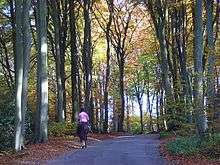 |
23.0 hectares (57 acres) | YES | Marlow 51°34′07″N 0°48′55″W / 51.5687°N 0.8154°W SU822862 |
BBOWT,[70] CAONB,[71] WT[70] | Map | Citation | A large part of the site is mature beech woodland, the result of neglected coppicing. Much of the ground below the trees is bare, but there are some unusual plants, including the nationally rare ghost orchid. There is heather in more open areas.[71] | ||
| Homefield Wood | 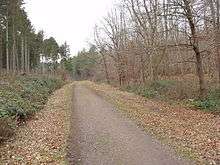 |
6.1 hectares (15 acres) | YES | Hambleden 51°34′24″N 0°49′42″W / 51.5733°N 0.8283°W SU813867 |
BBOWT,[72] CAONB,[73] FC[73] | Map | Citation | The site has young beech plantations, with some conifers and many native trees. There are rides and glades with varied herb-rich chalk grassland, and a variety of orchids. The rich invertebrate fauna includes thirty species of butterfly and over four hundred of moth.[73][72] | ||
| Howe Park Wood | 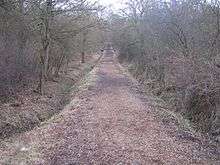 |
21.4 hectares (53 acres) | YES | Tattenhoe 52°00′06″N 0°47′17″W / 52.0018°N 0.7880°W SP833344 |
Map | Citation | The site is ancient semi-natural woodland on poorly drained clay, causing seasonal waterlogging, with some areas which are drier. There is a wide variety of trees and shrubs, and almost three hundred species of moths have been recorded. Butterflies include the nationally rare black hairstreak.[74] | |||
| Ivinghoe Hills | 212.3 hectares (525 acres) | YES | Ivinghoe 51°50′00″N 0°36′14″W / 51.8334°N 0.6038°W SP963159 |
CAONB,[75] NCR,[75] NT,[75] SM[75] | Map | Citation | The site is biologically rich, and it has varied habitats including unimproved chalk grassland, which has some nationally rare species, semi-natural woodland and scrub. There are two areas of ancient woodland.[75] | |||
| Kingcup Meadows and Oldhouse Wood | 13.2 hectares (33 acres) | YES | Denham 51°33′19″N 0°30′57″W / 51.5554°N 0.5157°W TQ030851 |
Map | Citation | This is a mosaic of different habitats next to the River Alder Bourne, including unimproved pasture and woodland. The meadows have dry and wet grassland, swamp and fen. Oldhouse Wood has ash and field maple on upper slopes and oak and birch on lower ones.[76] | ||||
| Kings and Bakers Woods and Heaths | 212.8 hectares (526 acres) | YES | Great Brickhill 51°57′23″N 0°39′19″W / 51.9563°N 0.6553°W |
NCR,[77] NNR,[78] WTBCN[79] | Map | Citation | The site has the largest remaining area of woodland in Bedfordshire, together with lowland heath, acidic grassland and some small ponds. There are a number of rare plant species, including great woodrush, wood vetch and saw-wort.[77] There are also abundant birds and insects, including white admiral butterflies and tree pipits.[79] | |||
| Littleworth Common | 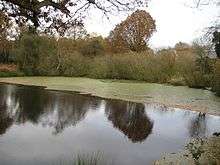 |
15.8 hectares (39 acres) | YES | Farnham Common 51°34′01″N 0°39′09″W / 51.5669°N 0.6524°W SU935862 |
Map | Citation | The site was formerly open heathland, most of which has developed into birch and oak woodland. Some remnants of acid heathland survive, and marshy areas and two large ponds have uncommon communities, including the nationally rare starfruit.[80] | |||
| Lodge Hill | 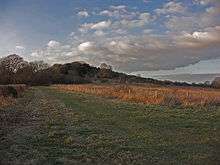 |
31.8 hectares (79 acres) | YES | Bledlow Ridge 51°41′38″N 0°51′09″W / 51.6940°N 0.8526°W SP794001 |
CAONB,[81] SM[82] | Map | Citation | The site is chalk grassland and scrub which is notable for its invertebrates, including butterflies. It has a rare snail, Abide secale, and populations of badgers and slowworms.[81] There is also a Bronze Age Bowl barrow.[82] | ||
| Long Herdon Meadow | 4.5 hectares (11 acres) | YES | Marsh Gibbon 51°52′36″N 1°03′36″W / 51.8766°N 1.0601°W SP648202 |
BBOWT[83] | Map | Citation | The site is a alluvial meadow next to the River Ray in the Vale of Aylesbury. It has clay soil and is liable to flooding. A regime of a hay cut followed by cattle grazing, without the use of artificial fertilisers, has resulted in a diverse grassland habitat now rare in England.[84] | |||
| Mid Colne Valley |  |
132.0 hectares (326 acres) | YES | Denham 51°35′44″N 0°29′44″W / 51.5956°N 0.4956°W TQ043896 |
Map | Citation | The valley has over 70 woodland and wetland breeding bird species, and 80 wintering wildfowl. It also has one of the few surviving areas of unimproved chalk grassland in Greater London, and woodland of pedunculate oak and ash.[85] | |||
| Millfield Wood | 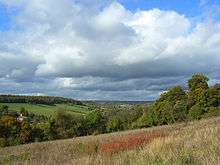 |
9.5 hectares (23 acres) | YES | High Wycombe 51°39′03″N 0°44′38″W / 51.6507°N 0.7439°W SU870954 |
BBOWT,[86] CAONB[87] | Map | Citation | this is semi-natural beech woodland on chalk, which is an unusual habitat, and it also has considerable wych elm. Its rich ground flora includes some ancient woodland and nationally restricted species, and many wild flowers, which is unusual in beech woodland.[87][86] | ||
| Moorend Common | 28.0 hectares (69 acres) | YES | Lane End 51°36′27″N 0°50′36″W / 51.6076°N 0.8433°W SU802905 |
CAONB[88] | Map | Citation | The site is on London Clay, which is unusual for the Chilterns, and the soil is acid and sometimes waterlogged. Habitats are grassland, heath, woodland, marsh and scrub. Marshy areas have heath spotted orchid and bog mosses.[88] | |||
| Muswell Hill | 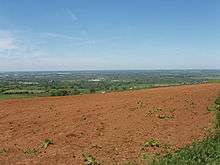 |
0.3 hectares (0.74 acres) | YES | Brill 51°49′58″N 1°04′21″W / 51.8327°N 1.0726°W SP640153 |
GCR[89] | Map | Citation | This site has sandstones and sandy ironstones. It is problematic as their precise age and the circumstances of deposition are uncertain, but they are thought to be early Cretaceous, with late Jurassic underlying layers.[90] | ||
| Naphill Common | 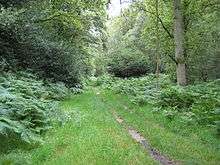 |
71.7 hectares (177 acres) | YES | Naphill 51°40′02″N 0°47′12″W / 51.6673°N 0.7868°W SU840972 |
CAONB,[91] NCR[91] | Map | Citation | This oak and beech wood has diverse trees and shrubs, areas of acid heath, wet rides and ponds. Many of the oaks and beech trees are ancient pollards. Heathland clearings have some species which are uncommon in the county, such as heath bedstraw and the heather Calluna vulgaris.[91] | ||
| Old Rectory Meadows | 7.9 hectares (20 acres) | NO | Denham 51°34′34″N 0°30′39″W / 51.5760°N 0.5107°W TQ033874 |
Map | Citation | This site on the bank of the River Misbourne has wet alluvial and water meadows, marsh and alder carr woodland. It has plants which are rare in the county such as marsh arrowgrass, and its irregular structure provides a suitable habitat for insects.[92] | ||||
| Oxley Mead | 3.7 hectares (9.1 acres) | YES | Milton Keynes 52°00′20″N 0°48′30″W / 52.0056°N 0.8083°W SP819348 |
Map | Citation | The site is an ancient hay meadow which has a nationally rare plant community, due to its traditional management. The main plants are herbs such as great burnet and meadow sweet, and grasses include meadow foxtail and sweet vernal-grass.[93] | ||||
| Pilch Fields |  |
11.1 hectares (27 acres) | YES | Great Horwood 51°59′00″N 0°54′49″W / 51.9832°N 0.9137°W SP747322 |
BBOWT[94] | Map | Citation | The site has two fields called Big Pilch and Little Pilch. The varied habitats in Big Pilch include wetland, fen, scrub, a stream and ridge-and-furrow grassland. The stream continues into Little Pilch, which has spring-fed fen and grassland. Over two hundred flowering plants have been recorded.[95] | ||
| Pitstone Hill |  |
22.9 hectares (57 acres) | YES | Ivinghoe 51°49′16″N 0°37′23″W / 51.8211°N 0.6231°W SP950145 |
CAONB[96] | Map | Citation | The site is chalk grassland on a steeply sloping hill, with small areas of woodland and scrub. Flowers include the nationally scarce pasque flower and field fleawort. Twenty-six species of butterfly have been recorded, and breeding birds include skylarks, meadow pipits and willow warblers.[96] | ||
| Pitstone Quarry | 10.3 hectares (25 acres) | PP | Ivinghoe 51°49′13″N 0°38′52″W / 51.8204°N 0.6478°W SP933144 |
Map | Citation | The site exposes deposits of the Middle and Late Pleistocene, during the last half-million years. Most sediments date to ice ages, but those from the latest warm period, the Ipswichian around 125,000 years ago, contains hippopotamus fossils.[97] | ||||
| Poker's Pond Meadow | 1.9 hectares (4.7 acres) | NO | Soulbury 51°56′37″N 0°43′21″W / 51.9436°N 0.7226°W SP879280 |
Map | Citation | The site is ancient hay meadow which has been traditionally managed, and has the remains of medieval ridge and furrow ploughing. There is a marshy area, but most of the field is dry grassland, with an unusually wide variety of plants, and over 100 species of grasses, sedges, herbs and rushes have been recorded.[98] | ||||
| Rodbed Wood | 2.2 hectares (5.4 acres) | FP | Medmenham 51°32′44″N 0°50′31″W / 51.5456°N 0.8420°W SU804836 |
CAONB[99] | Map | Citation | The site is wet willow and alder woodland close to the River Thames, fed by a ditch from neighbouring water meadows. The understorey has blackthorn, hawthorn and guelder rose. There is a diverse flora, including the nationally rare summer snowflake. There is a rich invertebrate fauna.[99] | |||
| Rushbeds Wood and Railway Cutting | 80.2 hectares (198 acres) | PP | Wotton Underwood 51°50′03″N 1°02′00″W / 51.8341°N 1.0334°W SP667155 |
BBOWT[100] | Map | Citation | The site is ancient woodland on heavy clay soils which are often waterlogged. The invertebrate fauna are described by Natural England as "exceptional", including over thirty butterfly species, such as the nationally rare black hairstreak and the scarce wood white and purple emperor.[101] | |||
| Shabbington Woods Complex |  |
305.6 hectares (755 acres) | YES | Long Crendon 51°47′39″N 1°06′35″W / 51.7943°N 1.1097°W SP615110 |
BBOWT,[102] FC[103] | Map | Citation | The site is the largest remnant of the former Royal Forest of Bernwood. There is a small area of ancient woodland and two unimproved meadows, bounded by mature hedges, and several ponds. The main ecological interest is the rich insect fauna, and over forty species of butterfly have been recorded, including the rare Duke of Burgundy.[103] | ||
| Sheephouse Wood | 56.9 hectares (141 acres) | PP | Charndon 51°54′20″N 0°58′46″W / 51.9056°N 0.9795°W SP703235 |
Map | Citation | The site has ancient pedunculate oak woodland with many small streams and diverse ground flora, typical breeding birds and some uncommon invertebrates. Invertebrates include the rare black hairstreak butterfly and ground-hopper tetrix subulata.[104] | ||||
| South Lodge Pit | 0.5 hectares (1.2 acres) | NO | Taplow 51°31′44″N 0°41′46″W / 51.5290°N 0.6962°W SU905819 |
GCR[105] | Map | Citation | This former chalk quarry dates to the late Cretaceous, around 83 million year ago, when sea levels were much higher, and marine fossils are found in several horizons, including annelids, oysters and bivalves. It is the only British example of a chalk phosphorite deposit, comparable to deposits in the Paris Basin.[106][107][108] | |||
| Stoke Common | 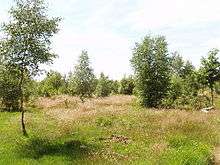 |
83.2 hectares (206 acres) | YES | Stoke Poges 51°33′29″N 0°34′50″W / 51.5580°N 0.5806°W SU985853 |
Map | Citation | The site is a last remnant of a large heath, and is on glacial gravel over London clay, with some parts permanently waterlogged. There is a rich invertebrate fauna, especially moths, and the dusky cockroach and rare bog bush cricket have also been recorded.[109] | |||
| Stone | 0.1 hectares (0.25 acres) | NO | Stone 51°48′24″N 0°52′23″W / 51.8066°N 0.8730°W SP778126 |
GCR[110] | Map | Citation | This site has undated sands of Lower Cretaceous Wealden deposits. The sand is of northern origin, and includes Carboniferous chert. The site is described by Natural England as important for its bearing on the palaeogeography of the Wealden.[111] | |||
| Swain's Wood | 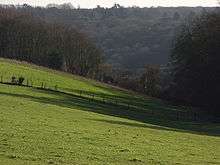 |
16.2 hectares (40 acres) | NO | Turville 51°37′19″N 0°56′02″W / 51.6220°N 0.9339°W SU739920 |
BBOWT,[56] CAONB[112] | Map | Citation | The site is in the upper slopes of a valley, with grassland and scrub, flanked by woodland on both sides. The grassland has varied plant and invertebrate species, and around 117 species of spider and over 160 of butterflies and moths have been recorded.[112] | ||
| Temple Island Meadows | 14.1 hectares (35 acres) | YES | Henley-on-Thames 51°33′22″N 0°53′32″W / 51.5560°N 0.8922°W SU769847 |
Map | Citation | The site is composed of several wet meadows which are grazed by sheep. They are seasonally flooded and waterlogged, and have a diverse flora and fauna. Plants include the nationally rare summer snowflake, and marsh and early marsh orchids.[113] | ||||
| Tingewick Meadows | 11.1 hectares (27 acres) | YES | Tingewick 51°58′35″N 1°03′08″W / 51.9763°N 1.0522°W SP652313 |
Map | Citation | The meadows have areas of ancient ridge and furrow, and of marsh and ditches which are fed by springs. The grassland has a rich variety of plant species, some of which are rare in the Vale of Aylesbury, such as the quaking grass briza media and the dwarf thistle cirsium acaule.[114] | ||||
| Tring Reservoirs |  |
106.5 hectares (263 acres) | YES | Tring 51°48′49″N 0°40′06″W / 51.8135°N 0.6683°W SP919136 |
HMWT[115] | Map | Citation | These four reservoirs are important for birds, including nationally important numbers of wintering shovellers, and a diverse breeding community. It is also important for invertebrates such as dragonflies.[116] | ||
| Turville Hill |  |
22.4 hectares (55 acres) | YES | High Wycombe 51°36′55″N 0°53′27″W / 51.6153°N 0.8907°W SU769913 |
CAONB[117] | Map | Citation | This is steeply sloping grazed chalk grassland with a wide variety of plants. Two butterflies are rare, the silver spotted skipper and the Adonis blue. Another scarce invertebrate is the orange clearwing moth.[117] | ||
| Warren Farm, Stewkley | 1.5 hectares (3.7 acres) | NO | Stewkley 51°54′35″N 0°45′51″W / 51.9098°N 0.7643°W SP851242 |
GCR[118] | Map | Citation | This site is the most northern exposure of the Jurassic Portlandian basin, and is important for palaeographic reconstruction. It is described by Natural England as "vital to our understanding of the late Jurassic environments, stratigraphy and palaeogeography.[119] | |||
| Weston Turville Reservoir |  |
18.4 hectares (45 acres) | YES | Weston Turville 51°46′42″N 0°45′07″W / 51.7784°N 0.7519°W SP862096 |
BBOWT,[120] CAONB[121] | Map | Citation | The open water is important for 46 species of over-wintering waterfowl, and the site is nationally important for shovelers. The areas around the reservoir have tall fen, reed beds and willow carr, declining habitats in Britain. There are over 300 species of beetle, of which six are rare nationally.[122] | ||
| Widdenton Park Wood | 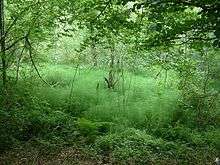 |
23.5 hectares (58 acres) | YES | High Wycombe 51°36′59″N 0°49′17″W / 51.6164°N 0.8214°W SU817915 |
CAONB[123] | Map | Citation | This is ancient semi-natural oak-beech woodland, which supports a varied flora including several uncommon species. The most important feature is a number of extensive spring-fed mires, dominated by willow and birch.[123] | ||
| Windsor Hill | 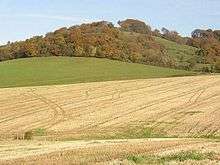 |
61.8 hectares (153 acres) | PP | Princes Risborough 51°37′38″N 0°55′20″W / 51.6273°N 0.9222°W SU747926 |
BBOWT,[56] CAONB,[124] NCR[124] | Map | Citation | This site has beech woodland, scrub and chalk grassland. The scrub has an ancient hedge and a colony of juniper, and 23 species of butterfly have been recorded, including brown hairstreaks.[124] | ||
| Wormsley Chalk Banks | 14.1 hectares (35 acres) | PP | Turville 51°38′14″N 0°55′30″W / 51.6372°N 0.9249°W SU745937 |
CAONB[125] | Map | Citation | The site has chalk grassland which is rich in both plant and invertebrate species which have sharply declined nationally. Flowers include bee and fly orchids, the latter of which is becoming scarce. Invertebrates include a variety of butterflies, harvest spiders and slowworms.[125] | |||
| Yardley Chase |  |
353.1 hectares (873 acres) | PP | Olney 52°10′33″N 0°45′14″W / 52.1759°N 0.7540°W SP853538 |
Map | Citation | This Chase has diverse semi-natural habitats, and its value for invertebrates has been enhanced by military use of the site, which has resulted in a long absence of intensive agriculture. There is woodland and unimproved grassland, and 30 breeding butterfly species have been recorded.[126] |
See also
| Wikimedia Commons has media related to Sites of Special Scientific Interest in Buckinghamshire. |
Notes
References
- ↑ "South East (England)". Office for National Statistics. Archived from the original on 5 January 2016. Retrieved 19 April 2016.
- ↑ "Aylesbury". Visit Buckinghamshire. Retrieved 19 April 2016.
- ↑ The Ordnance Survey Atlas of Great Britain. London, UK: Book Club Associates. 1982. p. 189.
- ↑ "Your Guide to the Counties of England". Counties in England. Retrieved 9 December 2015.
- ↑ "Buckinghamshire Quick Facts & Figures". Essential Travel Guide. Retrieved 19 April 2016.
- ↑ "Sites of Special Scientific Interest: Designation". Natural England. Retrieved 19 April 2016.
- ↑ "Sites of Special Scientific Interest, Search results for Buckinghamshire". Natural England. Retrieved 19 April 2016.
- 1 2 3 "Ashridge Commons and Woods citation" (PDF). Sites of Special Scientific Interest. Natural England. Archived from the original (PDF) on 4 March 2016. Retrieved 4 January 2016.
- 1 2 3 "Aston Clinton Ragpits citation" (PDF). Sites of Special Scientific Interest. Natural England. Retrieved 4 January 2016.
- 1 2 "Aston Rowant citation" (PDF). Sites of Special Scientific Interest. Natural England. Retrieved 4 January 2016.
- ↑ Ratcliffe, Derek A. (1977). A Nature Conservation Review. 2. Cambridge University Press. p. 121. ISBN 9780521214032.
- ↑ "Aston Rowant". Joint Nature Conservation Committee. Retrieved 25 February 2016.
- ↑ "Aston Rowant (SAC)". Natural England. Retrieved 25 February 2016.
- ↑ "Aston Rowant citation" (PDF). Sites of Special Scientific Interest. Natural England. Retrieved 24 June 2016.
- ↑ "Chilterns Area of Outstanding Natural Beauty Management Plan 2014 – 2019" (PDF). Chilterns Conservation Board. April 2014. p. 14. Retrieved 4 January 2016.
- ↑ Ratcliffe, Derek A. (1977). A Nature Conservation Review. 2. Cambridge University Press. p. 53. ISBN 9780521214032.
- ↑ Biodiversity Designations Background Paper. Wycombe District Council. June 2009. pp. 9, 10. Retrieved 19 April 2016.
- ↑ "Chilterns Beechwoods". Joint Nature Conservation Committee. Retrieved 25 February 2016.
- ↑ "Chilterns Beechwoods (SAC)". Natural England. Retrieved 25 February 2016.
- ↑ "Aston Rowant Woods citation" (PDF). Sites of Special Scientific Interest. Natural England. Retrieved 26 February 2016.
- ↑ "Bacombe Hill". Berkshire, Buckinghamshire and Oxfordshire Wildlife Trust. Retrieved 4 January 2016.
- ↑ "Bacombe Hill Local Nature Reserve". Chilterns Conservation Board. Retrieved 4 January 2015.
- ↑ "Bacombe Hill". Local Nature Reserves. Natural England. 8 August 2013. Retrieved 4 January 2015.
- ↑ "Chilterns Countryside". National Trust. Retrieved 28 September 2015.
- ↑ "Bacombe and Coombe Hills citation" (PDF). Sites of Special Scientific Interest. Natural England. Retrieved 4 January 2015.
- ↑ "Bierton (Portlandian – Berriasian)". Nature Conservation Committee. Retrieved 9 January 2016.
- ↑ "Bierton Clay Pit citation" (PDF). Sites of Special Scientific Interest. Natural England. Archived from the original (PDF) on 25 January 2016. Retrieved 7 January 2016.
- ↑ "Black Park". Local Nature Reserves. Natural England. 4 June 2015. Retrieved 4 January 2016.
- ↑ "Black Park citation" (PDF). Sites of Special Scientific Interest. Natural England. Archived from the original (PDF) on 31 December 2014. Retrieved 30 December 2014.
- ↑ "Bolter End (Palaeogene)". Joint Nature Conservation Committee. Retrieved 5 February 2016.
- ↑ "Bolter End Sand Pit SSSI". Bucks Geology. Retrieved 5 February 2016.
- 1 2 3 "Bradenham Woods, Park Wood and The Coppice citation" (PDF). Sites of Special Scientific Interest. Natural England. Archived from the original (PDF) on 31 December 2014. Retrieved 8 January 2016.
- 1 2 "Bradenham Estate". National Trust. Retrieved 8 January 2016.
- ↑ "Sections of Grims Ditch". Historic England. Retrieved 8 January 2016.
- 1 2 "Bugle Pit (Portlandian – Berriasian)". Joint Nature Conservation Committee. Retrieved 10 January 2016.
- ↑ "Bugle Pit, Hartwell (Jurassic – Cretaceous Reptilia)". Joint Nature Conservation Committee. Retrieved 10 January 2016.
- ↑ "Bugle Quarry citation" (PDF). Sites of Special Scientific Interest. Natural England. Archived from the original (PDF) on 4 March 2016. Retrieved 10 January 2016.
- ↑ "Buckinghamshire's National Nature Reserve: Burnham Beeches". Natural England. Retrieved 13 October 2015.
- ↑ "Burnham Beeches and Stoke Common". City of London. Retrieved 13 October 2015.
- ↑ "Slight univallate hillfort at Seven Ways Plain, Burnham Beeches". Historic England. Retrieved 8 January 2016.
- ↑ "Burnham Beeches citation" (PDF). Sites of Special Scientific Interest. Natural England. Archived from the original (PDF) on 24 January 2016. Retrieved 13 October 2015.
- 1 2 "Buttler's Hangings citation" (PDF). Sites of Special Scientific Interest. Natural England. Retrieved 18 February 2016.
- ↑ "Dancersend". Berkshire, Buckinghamshire and Oxfordshire Wildlife Trust. Retrieved 10 October 2015.
- 1 2 3 "Dancersend citation" (PDF). Sites of Special Scientific Interest. Natural England. Retrieved 10 October 2015.
- 1 2 "Dancersend Waterworks citation" (PDF). Sites of Special Scientific Interest. Natural England. Retrieved 10 October 2015.
- ↑ "Cooling Pond, List entry Number: 1418490". Historic England. Retrieved 10 October 2015.
- 1 2 "Ellesborough and Kimble Warrens citation" (PDF). Sites of Special Scientific Interest. Natural England. Archived from the original (PDF) on 31 December 2014. Retrieved 6 January 2015.
- ↑ "Pillow mound on Beacon Hill, 550m south of Ellesborough church. List entry Number: 101394". English Heritage. Retrieved 6 January 2015.
- ↑ "Lottery grant to conserve rare woodland". Chilterns Conservation Board. 24 October 2012. Retrieved 6 January 2015.
- 1 2 "Fayland Chalk Bank citation" (PDF). Sites of Special Scientific Interest. Natural England. Retrieved 6 February 2016.
- ↑ "Fern House Gravel Pit (Quaternary of the Thames)". Joint Nature Conservation Committee. Retrieved 28 February 2016.
- ↑ Bridgland, D. R. (1994). "Fern House Gravel Pit". Quaternary of the Thames. Springer. ISBN 9789401107051.
- ↑ "Fern House Gravel Pit SSSI". Bucks Geology. Retrieved 28 February 2016.
- 1 2 "Finemere Wood". Berkshire, Buckinghamshire and Oxfordshire Wildlife Trust. Retrieved 9 January 2016.
- ↑ "Finemere Wood citation" (PDF). Sites of Special Scientific Interest. Natural England. Retrieved 7 January 2015.
- 1 2 3 "Permit only reserves". Berkshire, Buckinghamshire and Oxfordshire Wildlife Trust. Retrieved 9 January 2016.
- ↑ "Foxcote Reservoir and Wood citation" (PDF). Sites of Special Scientific Interest. Natural England. Retrieved 8 January 2015.
- ↑ "Frieth Meadows citation" (PDF). Sites of Special Scientific Interest. Natural England. Retrieved 9 February 2016.
- ↑ "Froghall Brickworks SSSI". Bucks Geology. Retrieved 18 April 2016.
- ↑ "The Chess Valley Walk" (PDF). Chilterns Conservation Board. Retrieved 9 January 2016.
- ↑ "Frogmore Meadows citation" (PDF). Sites of Special Scientific Interest. Natural England. Archived from the original (PDF) on 3 March 2016. Retrieved 11 December 2014.
- ↑ "Frogmore Meadow". Herts and Middlesex Wildlife Trust. Retrieved 11 December 2014.
- 1 2 "Gomm Valley". Berkshire, Buckinghamshire and Oxfordshire Wildlife Trust. Retrieved 9 January 2015.
- ↑ "Gomm Valley". Chilterns Conservation Board. Retrieved 9 January 2015.
- ↑ "Gomm Valley citation" (PDF). Sites of Special Scientific Interest. Natural England. Archived from the original (PDF) on 4 March 2016. Retrieved 9 January 2015.
- 1 2 3 4 "Grangelands and Pulpit Hill citation" (PDF). Sites of Special Scientific Interest. Natural England. Retrieved 10 January 2015.
- ↑ "Grendon and Doddershall Woods citation" (PDF). Sites of Special Scientific Interest. Natural England. Retrieved 24 September 2015.
- ↑ "Ham Home-cum-Hamgreen Woods citation" (PDF). Sites of Special Scientific Interest. Natural England. Archived from the original (PDF) on 4 March 2016. Retrieved 13 March 2016.
- 1 2 3 "Hodgemoor Wood citation" (PDF). Sites of Special Scientific Interest. Natural England. Retrieved 25 September 2015.
- 1 2 "Community Wildlife Officer (Bucks)" (PDF). Berkshire, Buckinghamshire and Oxfordshire Wildlife Trust. Retrieved 28 September 2015.
- 1 2 "Pullingshill and Hollowhill Woods citation" (PDF). Sites of Special Scientific Interest. Natural England. Retrieved 28 September 2015.
- 1 2 "Homefield Wood". Berkshire, Buckinghamshire & Oxfordshire Wildlife Trust. Retrieved 29 September 2015.
- 1 2 3 "Homefield Wood citation" (PDF). Sites of Special Scientific Interest. Natural England. Retrieved 29 September 2015.
- ↑ "Howe Park Wood citation" (PDF). Sites of Special Scientific Interest. Natural England. Archived from the original (PDF) on 29 September 2015. Retrieved 28 September 2015.
- 1 2 3 4 5 "Ivinghoe Hills citation" (PDF). Sites of Special Scientific Interest. Natural England. Retrieved 30 September 2015.
- ↑ "Kingcup Meadows and Oldhouse Wood citation" (PDF). Sites of Special Scientific Interest. Natural England. Archived from the original (PDF) on 3 March 2016. Retrieved 13 March 2016.
- 1 2 "Kings and Bakers Woods and Heaths citation" (PDF). Sites of Special Scientific Interest. Natural England. Retrieved 27 August 2015.
- ↑ "Bedfordshire's National Nature Reserves". Natural England. Retrieved 27 August 2015.
- 1 2 "King's Wood and Rammamere Heath". Wildlife Trust for Bedfordshire, Cambridgeshire and Northamptonshire. Retrieved 27 August 2015.
- ↑ "Littleworth Common citation" (PDF). Sites of Special Scientific Interest. Natural England. Archived from the original (PDF) on 3 March 2016. Retrieved 13 October 2015.
- 1 2 "Lodge Hill citation" (PDF). Sites of Special Scientific Interest. Natural England. Retrieved 30 September 2015.
- 1 2 "Bowl barrow on Lodge Hill, 650m east of Old Callow Down Farm". Historic England. Retrieved 9 January 2016.
- ↑ "Upper Ray Meadows". Berkshire, Buckinghamshire and Oxfordshire Wildlife Trust. Retrieved 5 March 2016.
- ↑ "Long Herdon Meadow citation" (PDF). Sites of Special Scientific Interest. Natural England. Retrieved 20 March 2016.
- ↑ "Mid Colne Valley citation" (PDF). Sites of Special Scientific Interest. Natural England. Retrieved 28 June 2016.
- 1 2 "Millfield Wood". Berkshire, Buckinghamshire and Oxfordshire Wildlife Trust. Retrieved 11 October 2015.
- 1 2 "Millfield Wood citation" (PDF). Sites of Special Scientific Interest. Natural England. Retrieved 11 October 2015.
- 1 2 "Moorend Common citation" (PDF). Sites of Special Scientific Interest. Natural England. Retrieved 11 October 2015.
- ↑ "Muswell Hill (Wealden)". Joint Nature Conservation Committee. Retrieved 9 January 2016.
- ↑ "Muswell Hill citation" (PDF). Sites of Special Scientific Interest. Natural England. Archived from the original (PDF) on 25 January 2016. Retrieved 11 October 2015.
- 1 2 3 "Naphill Common citation" (PDF). Sites of Special Scientific Interest. Natural England. Retrieved 14 October 2015.
- ↑ "Old Rectory Meadows citation" (PDF). Sites of Special Scientific Interest. Natural England. Retrieved 13 March 2016.
- ↑ "Oxley Mead citation" (PDF). Sites of Special Scientific Interest. Natural England. Retrieved 20 March 2016.
- ↑ "Pilch Field". Berkshire, Buckinghamshire and Oxfordshire Wildlife Trust. Retrieved 12 October 2015.
- ↑ "Pilch Fields". Milton Keynes Natural History Society. Retrieved 12 October 2015.
- 1 2 "Pitstone Hill citation" (PDF). Sites of Special Scientific Interest. Natural England. Retrieved 14 October 2015.
- ↑ "Pitstone Quarry citation" (PDF). Sites of Special Scientific Interest. Natural England. Retrieved 9 October 2015.
- ↑ "Poker's Pond Meadow citation" (PDF). Sites of Special Scientific Interest. Natural England. Retrieved 20 March 2016.
- 1 2 "Rodbed Wood citation" (PDF). Sites of Special Scientific Interest. Natural England. Archived from the original (PDF) on 4 March 2016. Retrieved 11 April 2016.
- ↑ "Rushbeds Wood". Berkshire, Buckinghamshire and Oxfordshire Wildlife Trust. Retrieved 15 March 2016.
- ↑ "Rushbeds Wood and Railway Cutting citation" (PDF). Sites of Special Scientific Interest. Natural England. Archived from the original (PDF) on 4 March 2016. Retrieved 7 April 2016.
- ↑ "Bernwood Meadows". Berkshire, Buckinghamshire and Oxfordshire Wildlife Trust. Retrieved 14 October 2015.
- 1 2 "Shabbington Woods Complex citation" (PDF). Sites of Special Scientific Interest. Natural England. Retrieved 14 October 2015.
- ↑ "Sheephouse Wood citation" (PDF). Sites of Special Scientific Interest. Natural England. Archived from the original (PDF) on 4 March 2016. Retrieved 20 March 2016.
- ↑ "South Lodge Pit (Cenomanian, Turonian, Senonian, Maastrichtian)". Joint Nature Conservation Committee. Retrieved 29 February 2016.
- ↑ "South Lodge Pit citation" (PDF). Sites of Special Scientific Interest. Natural England. Retrieved 29 February 2016.
- ↑ "South Lodge Pit". Taplow Society. Retrieved 29 February 2016.
- ↑ "South Lodge Pit SSSI". Bucks Geology. Retrieved 29 February 2016.
- ↑ "Stoke Common citation" (PDF). Sites of Special Scientific Interest. Natural England. Archived from the original (PDF) on 3 March 2016. Retrieved 12 October 2015.
- ↑ "Stone (Wealden)". Joint Nature Conservation Committee. Retrieved 9 January 2016.
- ↑ "Stone citation" (PDF). Sites of Special Scientific Interest. Natural England. Archived from the original (PDF) on 25 January 2016. Retrieved 7 January 2016.
- 1 2 "Swain's Wood citation" (PDF). Sites of Special Scientific Interest. Natural England. Retrieved 12 October 2015.
- ↑ "Temple Island Meadows citation" (PDF). Sites of Special Scientific Interest. Natural England. Archived from the original (PDF) on 4 March 2016. Retrieved 14 April 2016.
- ↑ "Tingewick Meadows citation" (PDF). Sites of Special Scientific Interest. Natural England. Retrieved 7 April 2016.
- ↑ "Tring Reservoirs". Herts and Middlesex Wildlife Trust. Retrieved 19 April 2015.
- ↑ "Tring Reservoirs citation" (PDF). Sites of Special Scientific Interest. Natural England. Retrieved 29 June 2016.
- 1 2 "Turville Hill citation" (PDF). Sites of Special Scientific Interest. Natural England. Archived from the original (PDF) on 4 March 2016. Retrieved 13 October 2015.
- ↑ "Warren Farm (Portlandian – Berriasian)". Joint Nature Conservation Committee. Retrieved 20 March 2016.
- ↑ "Warren Farm, Stewkley citation" (PDF). Sites of Special Scientific Interest. Natural England. Retrieved 20 March 2016.
- ↑ "Weston Turville Reservoir". Berkshire, Buckinghamshire and Oxfordshire Wildlife Trust. Retrieved 13 October 2015.
- ↑ "Weston Turville Reservoir". Chilterns Conservation Board. Retrieved 13 October 2015.
- ↑ "Weston Turville Reservoir citation" (PDF). Sites of Special Scientific Interest. Natural England. Retrieved 13 October 2015.
- 1 2 "Widdenton Park Wood citation" (PDF). Sites of Special Scientific Interest. Natural England. Retrieved 13 October 2015.
- 1 2 3 "Windsor Hill citation" (PDF). Sites of Special Scientific Interest. Natural England. Retrieved 14 October 2015.
- 1 2 "Wormsley Chalk Banks citation" (PDF). Sites of Special Scientific Interest. Natural England. Retrieved 11 February 2016.
- ↑ "Yardley Chase citation" (PDF). Sites of Special Scientific Interest. Natural England. Retrieved 30 June 2016.